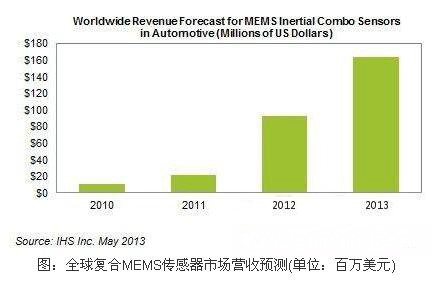 As more and more automobiles are introduced into safety systems, the number of composite MEMS inertial sensors for automobiles is also rapidly increasing, and the market is expected to reach US$163 million in 2013. The use of a hybrid sensor solution can significantly reduce costs, and it is not difficult to predict that composite sensors or future cars will be "standard."
As more and more automobiles are introduced into safety systems, the number of composite MEMS inertial sensors for automobiles is also rapidly increasing, and the market is expected to reach US$163 million in 2013. The use of a hybrid sensor solution can significantly reduce costs, and it is not difficult to predict that composite sensors or future cars will be "standard." Market research firm IHS iSuppli pointed out that thanks to the rapid adoption of automotive safety regulations and automotive safety system applications in recent years, it is expected that the market for hybrid MEMS inertial sensors for automotive applications in 2013 will be expected to reach a scale of US$163 million, a 77% increase. .
IHS said that as more cars are introduced into safety systems, the use of these types of sensors in automobiles is also rapidly increasing. Last year, this type of sensor market grew by approximately 338% to a market size of 92 million U.S. dollars, which is a significant increase from the 10 million U.S. dollars in 2011.
The composite inertial sensor refers to a multi-sensor element that integrates an accelerometer and a gyroscope in a single package, and provides an inertial input to an electronic stability control system (ESC) in a vehicle to avoid or reduce slipping.
Richard Dixon, chief analyst of MEMS and sensors at IHS, pointed out: "In North America, Europe and other places where regulations are mature, such as Australia, Japan, Canada and South Korea, the use of ESC is mandatory for automobiles, and there are still huge areas in some undeveloped areas. Business opportunities such as China provides a larger market, which will significantly affect the ESC's global penetration rate. However, from another point of view, it will also bring enormous benefits to the overall automotive hybrid sensors. Growth drive and kinetic energy."
IHS said that the main suppliers of composite inertial sensors for automobiles include Bosch in Germany and Murata in Japan. There are also two potential manufacturers, Panasonic in Japan and the headquarters in Maaju, USA. Deno (ADI) also needs to develop a similar solution in order to successfully grasp this market opportunity.
Future new models will use hybrid sensor solutions The current automotive ESC system includes three architectures: The first one is placed on a circuit board like a stand-alone ESC engine control unit (ECU). The second architecture is connected to a brake modulator to save cabling. The third type of ESC system is co-configured with the car airbag ECU.
In these three different configurations, the current trend is toward adopting the way of placing the ESC system in the airbag ECU, so as to achieve a smaller footprint and higher efficiency, especially in the space of the ECU in the vehicle. Therefore, it is more advantageous to adopt a space-saving architecture.
Compared to a stand-alone sensor configuration, sensors manufactured specifically for the combined sensor ESC system architecture (such as products developed by Continentail) can reduce space by up to five times, IHS emphasized. The non-combined solution also exists as a separate installation on the circuit board. According to IHS, deploying sensors in a complex manner not only reduces packaging costs, but also saves on the use of expensive semiconductor components because the two sensors in the composite package can share the same ASIC.
One of the most important issues in the ESC system is cost, IHS explains, because ESC was considered to be an option in the car. However, since the government forced the use of the ESC system, it has now become a must-have accessory for seatbelts.
Therefore, in the entire supply chain and pricing structure, automotive composite sensors experience tremendous pressure from the automotive manufacturer to the downstream. The first-line manufacturers pass this pressure to the suppliers and demand to accelerate the provision of high-efficiency, composite sensor solutions for the ESC system's inertial sensors.
IHS emphasizes that under this pressure, some first-line players believe that only the traditional business will be adopted in the future and traditional configuration solutions for PCBs with independent sensors will be adopted. Therefore, all future new models will use composite sensor solutions.
WF Series Parallel Shaft Helical Gear Reducer
Lawn Mower Gear Reducer,Gear Worm Box,Right Angle Gear Reducer,High Torque Gear Motor
RV Series Worm Reducer,WR Series Helical Gear Reducer Co., Ltd. , http://www.nbreducer.com